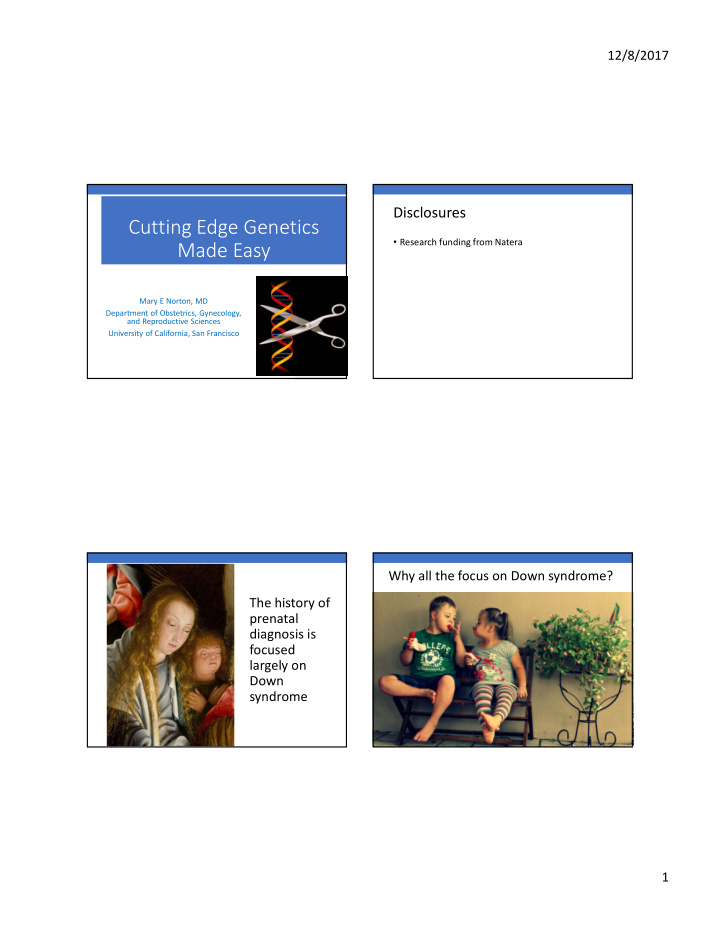



12/8/2017 Disclosures Cutting Edge Genetics • Research funding from Natera Made Easy Mary E Norton, MD Department of Obstetrics, Gynecology, and Reproductive Sciences University of California, San Francisco Why all the focus on Down syndrome? The history of prenatal diagnosis is focused largely on Down syndrome 1
12/8/2017 Lejeune, 1959 Tijo and Levan, 1956 1979: NICHD Consensus Panel on 1979 Cost Benefit Analysis Amniocentesis Care for child with Amniocentesis Down syndrome Everyone would Everyone would want it terminate 2
12/8/2017 “Remote shopping, while entirely feasible, will flop—because women like to get out of the house, like to handle merchandise, like to be able to change their minds.” ---Time magazine, 1966 Cell free DNA from apoptosis 1997 3
12/8/2017 Noninvasive Prenatal Testing (NIPT) for Analysis of cell free DNA aneuploidy using cell free DNA (cfDNA) • Detection requires accurate quantification of DNA from a specific chromosome • Somewhat different methods are utilized by different laboratories cfDNA screening for T21: meta-analysis cfDNA screening for T21: meta-analysis Massively Parallel Shotgun Sequencing (MPSS): ( Gil et al, Ultrasound Obstet Gynecol, 2015 ( Gil et al, Ultrasound Obstet Gynecol, 2017) Palomaki et al, 2011 • Random sampling of cfDNA fragments from all chromosomes • A z-score value is used as a cut-off for trisomy (z-score of 3) N=1696 DR: 99.7% (99.1- 99.9) FPR: 0.04% (0.02 - 0.07) Palomaki GE et al. DR: 99.2% (98.5 - 99.6) FPR: 0.09% (0.05 - 0.14) (2011), Genet. Med 4
12/8/2017 Cell free DNA and cancer Detection rate of prenatal screening for Down syndrome has improved over time 120 100 Detection Rate (%) 80 60 40 20 0 Estimate the Risk of Metastatic Relapse Estimate the Risk of Progression Monitor the efficacy of treatment Identifying Molecular Targets 5
12/8/2017 Meschino et al, Prenatal Diagn, 2016 6
12/8/2017 Prenatal diagnosis has largely relied on ultrasound and It’s a boy! karyotype with recent introduction of MRI and microarray Normal Female Chromosomes William’s Syndrome DOWN SYNDROME!! Two copies present Deletion 7q11.23 (Williams Syndrome) (normal) 7
12/8/2017 Microdeletions are genomic imbalances Chromosomal microarrays detected by microarray but not karyotype • “Lab-on-a-chip” • Detects thousands of microdeletions and duplications at the same time Miller et al, 2010, AJHG Chromosomal Microarray (CMA) for “Non-invasive Genome” Prenatal Diagnosis 8
12/8/2017 37 yo G1P0 at 28 wks Non-Invasive Single Gene Tests • Maternal and fetal cell free DNA cannot be easily distinguished • However, can identify de novo or paternal gene mutation • This includes blood type if mother is Rh negative and fetus is Rh positive • N=47 cases • Correct in 46 (96.2%) • Useful tool in 3 rd trimester to distinguish IUGR from achondroplasia Chitty LS, et al. Prenat Diagn 35:656, 2015 9
12/8/2017 Whole Genome and Whole Exome Sequencing • Whole Genome Sequencing • Obtaining the complete sequence of all 6 billion base pairs • De novo mutations of DNA in any individual • Many associated with advanced paternal age • Whole Exome Sequencing • Obtaining the complete sequence of the ~2% of the genome containing the exons that encode proteins 10
12/8/2017 Whole Exome Sequencing “Trio” 36 yo with two prior abnormal pregnancies • Severe ventriculomegaly • Midface hypoplasia • Bilateral echogenic kidneys • MSAFP: 18 MoM • Amnio: AFAFP 45 MoM • Normal microarray 11
12/8/2017 Next pregnancy: WES results • In vitro fertilization with preimplantation genetic testing • Embryos testing for chromosome abnormalities CRB2: p.W759X and for gene variants in CRB2 CRB2: p.N800K CRB2: p.W759X CRB2: p.W759X CRB2: p.N800K CRB2: p.N800K CRB2: p.W759X The future: Noninvasive whole genome Next pregnancy: sequencing? • In vitro fertilization with preimplantation genetic testing • Embryos testing for chromosome abnormalities and for gene variants in CRB2 • Embryo transferred that carried the maternal variant • Noninvasive prenatal test developed for the paternal variant as confirmatory reassurance 12
12/8/2017 Designer babies? 13
12/8/2017 What is “CRISPR”? What is “CRISPR”? What is “CRISPR”? • Part of bacterial immune • Clustered • Clustered system against invading • Regularly • Regularly viruses • Interspaced • Interspaced • Repeating sequences of genetic code • Short • Short • Used to target and • Palindromic • Palindromic modify “typos” in the • Repeats • Repeats three-billion-letter sequence of the human genome 14
12/8/2017 CRISPR-Cas9 gene editing system CRISPR 101 Cas9 enzyme can cut DNA at specific locations, and allow small segments of DNA to be added or removed. CRISPR is a collection of DNA sequences that tells Cas9 where to cut Clinical applications • Edit pig DNA so organs can be transplanted into humans • Inject CRISPR-edited WBCs into humans to treat cancer • Treat illnesses such as cystic fibrosis, sickle-cell anemia and Huntington's disease • Modify and repair embryos 15
12/8/2017 Gene correction in human embryos Gene correction in human embryos H Ma et al. Nature 1–7 (2017) doi:10.1038/nature23305 H Ma et al. Nature 1–7 (2017) doi:10.1038/nature23305 Conclusions • Technical details aside, Crispr-Cas9 makes it easy, cheap, and fast to move genes around— any genes, in any living thing, from bacteria to people. – David Baltimore 16
Recommend
More recommend